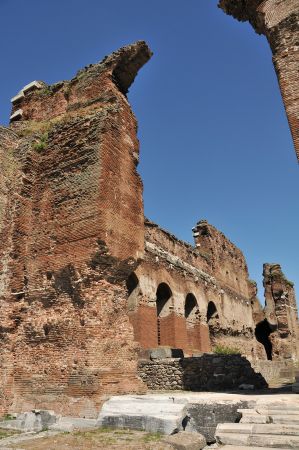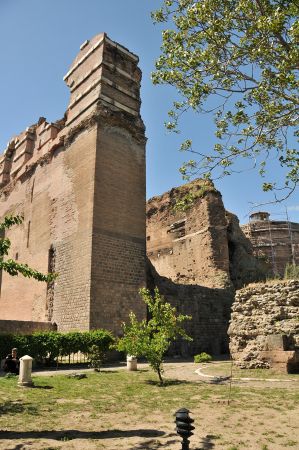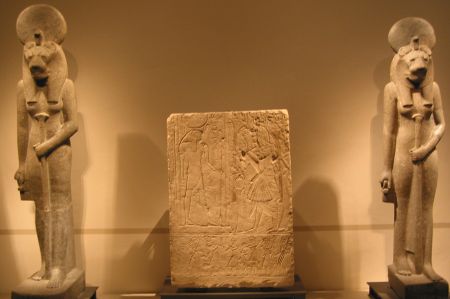The goddess Sekhmet is well known from Egyptian mythology because of her lion form in connection with her attribute "The Mighty One" through a multitude of different representations.
She was once the goddess of war but also of protection against diseases and their healing, her ancient nickname was "The Lady of Trembling". This goddess was often depicted as a seated or standing woman with a lion's head. In Egyptian mythology, she is the daughter of the sun god Re, the wife of Ptah and the mother of the lotus god Nefertem.
Torso parts of the goddess Sekhmet in Bergama
 During the excavation work by the German Archaeological Institute (DAI) at the red basilica in Bergama, parts of some huge marble statues were found in the last few decades, including parts of the torso of the goddess Sekhmet. At the time of the Romans it was quite common to include the gods of other peoples, even if they were often given new names. This is only a comment on the question that arises as to why an Egyptian goddess was placed at the Basilica of Bergama, since Sekhmet was worshiped in Memphis, Letopolis, Bubastis, Karnak, Esna and all the great temples in Nubia. In Memphis she formed a trinity with her husband Ptah and son Nefertem since the New Kingdom. Amenhotep III. had around 700 statues of Sekhmet erected in the Mut temple at Karnak, where both deities are represented with lion heads in their amalgamation into Mut Sekhmet.
During the excavation work by the German Archaeological Institute (DAI) at the red basilica in Bergama, parts of some huge marble statues were found in the last few decades, including parts of the torso of the goddess Sekhmet. At the time of the Romans it was quite common to include the gods of other peoples, even if they were often given new names. This is only a comment on the question that arises as to why an Egyptian goddess was placed at the Basilica of Bergama, since Sekhmet was worshiped in Memphis, Letopolis, Bubastis, Karnak, Esna and all the great temples in Nubia. In Memphis she formed a trinity with her husband Ptah and son Nefertem since the New Kingdom. Amenhotep III. had around 700 statues of Sekhmet erected in the Mut temple at Karnak, where both deities are represented with lion heads in their amalgamation into Mut Sekhmet.
According to some researchers, the statues served the cult of the goddess throughout the year: prayers were said in front of each statue on each day of the year to appease the goddess; at least one prayer was planned for each day. Other researchers are of the opinion that this temple served to ward off great dangers and suspect the plague to be behind it. The dead hastily buried in the country and the plague prayers of the neighbouring peoples, in which sick Egyptians are described, serve as evidence for this assumption.
From buildings from the Roman Empire to Ottoman residences
 German and Turkish archaeologists have now been able to reconstruct the statue of the goddess Sekhmet in Pergamon and solemnly hand it over to the public. The Acropolis in Pergamon, Turkey, now attracts around 450,000 visitors a year with its temples, palaces, barracks, colossal theatre and huge gymnasium. Although German archaeologists dug up the main altar in the 19th century and brought it to Berlin's Museum Island in thousands of boxes, they left enough material at this important Hellenistic-Roman archaeological site in north-western Turkey that today draws real crowds of tourists to the Burgberg and the affiliated museum attracts. On the other hand, hardly any archaeology tourists come to the immediately neighbouring Turkish district town of Bergama – the Turkish form of Pergamon. We recently reported on the Red Basilica on the occasion of a concert.
German and Turkish archaeologists have now been able to reconstruct the statue of the goddess Sekhmet in Pergamon and solemnly hand it over to the public. The Acropolis in Pergamon, Turkey, now attracts around 450,000 visitors a year with its temples, palaces, barracks, colossal theatre and huge gymnasium. Although German archaeologists dug up the main altar in the 19th century and brought it to Berlin's Museum Island in thousands of boxes, they left enough material at this important Hellenistic-Roman archaeological site in north-western Turkey that today draws real crowds of tourists to the Burgberg and the affiliated museum attracts. On the other hand, hardly any archaeology tourists come to the immediately neighbouring Turkish district town of Bergama – the Turkish form of Pergamon. We recently reported on the Red Basilica on the occasion of a concert.
Recently, archaeologists and restorers have been trying to upgrade the town of Bergama a little, because the modern city of Bergama has a lot to offer: from buildings from the Roman Imperial period to Ottoman dwellings from five centuries. The Red Hall in Pergamon is one of the most important and largest Roman cult sites in the entire eastern Mediterranean. It was built under Emperor Hadrian (reigned AD 117-138) around AD 130. Under him, at the foot of the castle hill, an imposing temple complex dedicated to several gods and the emperor cult was built, which is one of the most important and largest Roman complexes in the entire eastern Mediterranean region. Archaeological excavations since the 1930s have unearthed the remains of unique marble furnishings, including fragments of colossal Egyptian-style statues. They had once framed the two side courtyards of the large basilica in pairs as caryatids and atlases. These Egyptian supporting figures of the Red Hall can be counted among the most important Roman large sculptures in the east of the Roman Empire.
Sphinx figure from Hattusha
Since 2006, the archaeologist Felix Pirson and the building researcher Martin Bachmann, who jointly direct both the excavations in Pergamon and the Istanbul branch of the DAI, have been focusing on the ruins of this sanctuary, which was mainly built of bricks and is therefore called the "Red Hall". The first excavations at this site took place in the 1930s - also under the direction of the DAI, which has been working in Pergamon for over a hundred years with interruptions caused by the war. At that time, archaeologists discovered fragments of marble sculptures inside the Red Hall. The researchers concluded that the sanctuary was dedicated to an Egyptian deity, probably Isis or Serapis. In the meantime, the scientists have expanded the assumption made at the time: “In addition to Zeus-Serapis and the Anatolian mother goddess Cybele, the Roman emperor himself was probably also worshiped there,” says Bachmann.
Most recently, there had been considerable discord between German archaeologists and the Turkish authorities. had reclaimed the Sphinx figure from Hattusha. The high points of the dispute were the return demands of some Turkish politicians to the Pergamon Museum, the associated mutual accusations and the withdrawal of the archaeologists from the Eberhard Karls University of Tübingen from the traditional excavation site in Troy and from Göbeklitepe near Sanliurfa, which we also reported on.
Proconnesian marble from the Marmara Adası
In Pergamon, the cooperation seems to be running smoothly now. In cooperation with Turkish colleagues, the scientists from Berlin are gradually repairing the entire Red Hall complex. It is mostly about retaining walls and cellar vaults, the preservation of which is hardly noticeable to the layman and visitor. As part of this restoration work, generously supported by the Studiosus Foundation, it has been possible to recreate one of these figures from many fragments. Some of the lion-headed Egyptian goddess Sekhmet had already been set up on a trial basis for the first time last year. Now, however, it has received its final line-up with the mighty headdress at the impressive total height of 8.50 m. The figure is embedded in a test strip of the original floor and wall coverings made of precious types of marble, which was painstakingly reconstructed using original fragments. They are white Proconnesian marble from Marmara Adası, reddish-veined Pavonazzetto and black-grey marble from Afyon. The floor samples give an idea of the magnificent polychrome furnishings of the Red Hall, which today appears to be a pure brick building, robbed of its original cladding.
The restoration of the monumental sculpture and its decorative frame are based on current archaeological research results. Through their implementation in the original architectural context, they will give important new impetus to the discussion about the effects of ancient sculptures in space. As part of a new visitor concept, the goddess Sekhmet will significantly increase the didactic quality and attractiveness of the Red Hall for tourist visitors in the future.
This is how specialists become experts
The city administration wants to boost tourism in Pergamon with a new concept. The castle hill with its Hellenistic-Roman ruins, the modern city with its ancient and Ottoman monuments and the surrounding area are to be presented together and across epochs. The idea behind it: If you visit Pergamon, you should also come to Bergama if possible. In addition, the city administration wants to apply for a place on the UNESCO World Heritage List with the newly restored sites. In addition to the gain in prestige, inclusion in the list also brings with it economic advantages – the more well-known the city and site are, the more visitors there are.
In the long term, a second economic aspect of the reconstruction efforts could even prove to be more sustainable: the work in the Red Hall is carried out entirely by local craftsmen, some of whom have been working for the DAI for generations. This is how trained workers become experts.
Please read as well:
Tulumba Pastries and The Idecik Saints
Hiking Pfahlbaumuseum Unteruhldingen at Lake Constance


